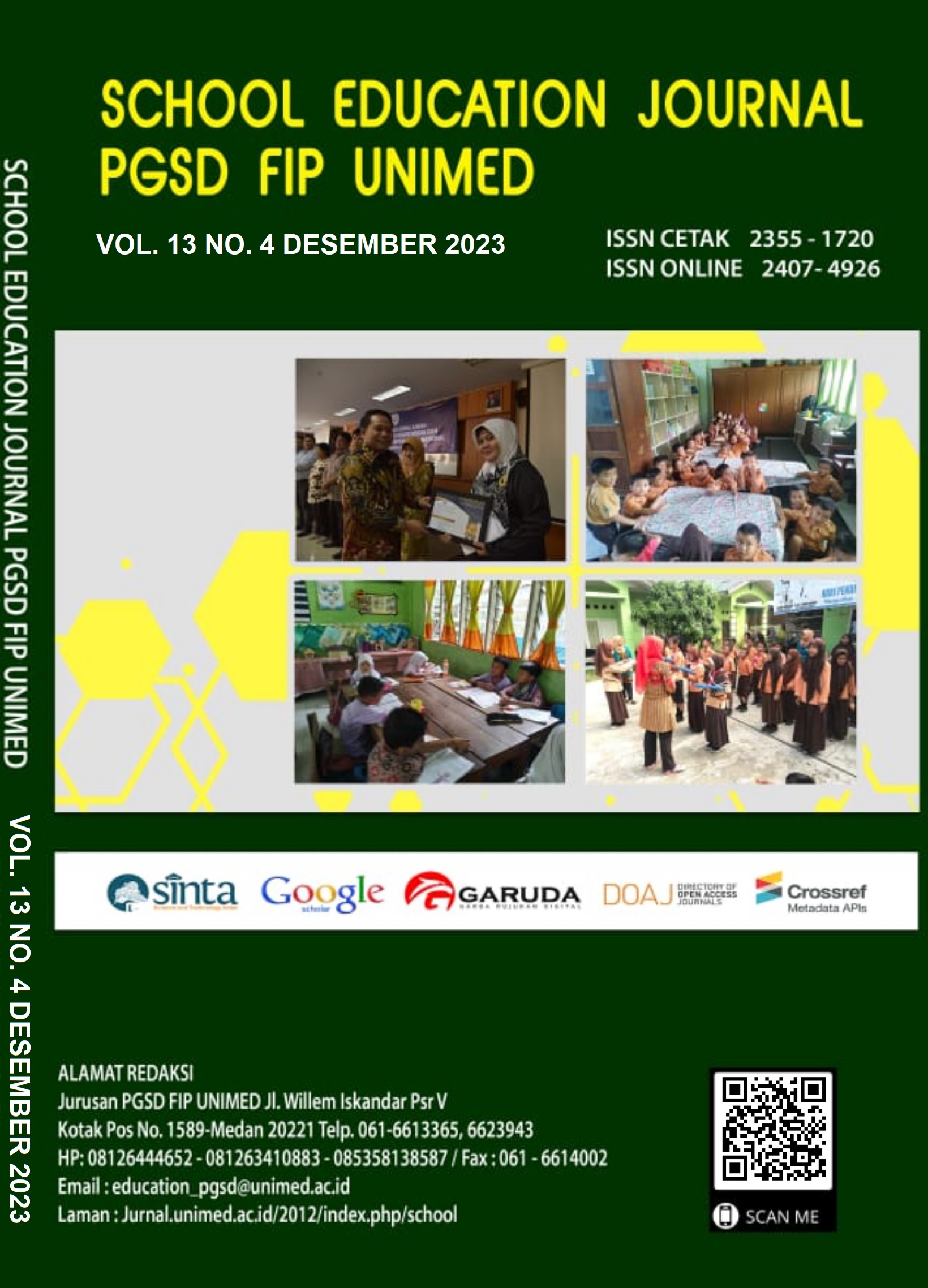PENERAPAN METODE DISKUSI KELOMPOK PADA MATA PELAJARAN MATEMATIKA KELAS 4 SDN GADANG 3 KOTA MALANG
DOI:
https://doi.org/10.24114/sejpgsd.v13i4.54398Keywords:
Learning methods, Learning Media, Group DiscussionsAbstract
The purpose of this study was to find out how the learning strategies and media were used to teach grade 4 mathematics at Gadang 3 Elementary School, Malang City. This research uses a descriptive qualitative research type. Data collection techniques in this study were by means of interviews, observation, and documentation. The subjects of this study were grade 4 teachers. The data analysis techniques used were data collection, data reduction, data display, and veryfying. The results of this study indicate that the existence of learning strategies in the form of study groups and joint discussions can improve student learning outcomes due to the heterogeneity of each group which encourages participants to learn competitively but still fun. Students are asked to help each other between friends so that other students do not feel left behind by the others. In addition to learning strategies, the learning media used are also the result of student designs, this makes students able to easily use these learning media. Learning media is also made of materials that are easily found around. Prior to implementing the study group strategy, grade 4 teachers had implemented several strategies. However, the class teacher considers this strategy to be the most effective in learning, especially in mathematics.References
Ariyana, I. K. S., & Suastika, I. N. 2022. Model Pembelajaran CIRC (Cooperative Integrated Reading And Composition) sebagai Salah Satu Strategi Pembelajaran Matematika di Sekolah Dasar. Jurnal Ilmiah Universitas Batanghari Jambi, 22(1), 203. https://doi.org/10.33087/jiubj.v22i1.2016
Azis, T. N. 2019. Strategi pembelajaran era digital. Annual Conference on Islamic Education and Social Sains (ACIEDSS 2019), 1(2), 308“318.
Azizah, N. 2022. Model Pembelajaran Small Group Discussiondalam Meningkatkan Motivasi Belajar Siswa pada Mata Pelajaran PAI. Jurnal Pendidikan Dan Konseling, 4(4), 1707“1715.
Dodi, I. 2019. Menggagas Pendidikan Nilai dalam Sistem Pendidikan Nasional. Didaktika: Jurnal Kependidikan, 8(3), 109“122. https://jurnaldidaktika.org/contents/article/view/73
Esminarto, E., Sukowati, S., Suryowati, N., & Anam, K. 2016. Implementasi model STAD dalam meningkatkan hasil belajar siwa. BRILIANT: Jurnal Riset Dan Konseptual, 1(1), 16“23.
Gita Gagulu, S. R. 2023. Peran Guru Dalam Mengatasi Kesulitan Belajar Siswa Pada Mata Pelajaran Matematika Menggunakan Metode Diskusi Kelompok. Journal of Education and Teaching Learning, 1(1), 6“11. https://doi.org/10.59211/mjpjetl.v1i1.10
Harsiwi, U. B., & Arini, L. D. D. 2020. Pengaruh Pembelajaran Menggunakan Media Pembelajaran Interaktif terhadap Hasil Belajar siswa di Sekolah Dasar. Jurnal Basicedu, 4(4), 1104“1113. https://doi.org/10.31004/basicedu.v4i4.505
Laura Malika, D., Endjid, P., & Magdalena, I. 2023. Perbedaan Model Metode Strategi Pendekatan Teknik Dan Taktik Dalam Pembelajaran Siswa Kelas 4 Sdn Poris Pelawad 5 Kota Tangerang. Educational Journal: General and Specific Research, 3(Februari), 164“167.
Maulidia, F. R., & Prafitasari, A. N. 2023. Strategi Pembelajaran Berdiferensiasi Dalam Memenuhi Kebutuhan Belajar Peserta Didik. ScienceEdu, 6(1), 55. https://doi.org/10.19184/se.v6i1.40019
Muslihah, N. N., & Suryaningrat, E. F. 2021. Model Pembelajaran Contextual Teaching and Learning terhadap Kemampuan Pemecahan Masalah Matematis. Plusminus: Jurnal Pendidikan Matematika, 1(3), 553“564. https://doi.org/10.31980/plusminus.v1i3.1445
Patilima, S. 2022. Sekolah Penggerak Sebagai Upaya Peningkatan Kualitas Pendidikan. Prosiding Seminar Nasional Pendidikan Dasar, 0(0), 228“236. http://ejurnal.pps.ung.ac.id/index.php/PSNPD/article/view/1069
Pendy, A., & Mbagho, H. M. 2020. Model Pembelajaran Number Head Together (NHT) Pada Materi Relasi dan Fungsi. Jurnal Basicedu, 5(1), 165“177. https://doi.org/10.31004/basicedu.v5i1.542
Putra, H. M., Setiawan, D.-, & Fajrie, N.-. 2020. Perilaku Kedisiplinan Siswa Dilihat Dari Etika Belajar Di Dalam Kelas. Jurnal Prakarsa Paedagogia, 3(1). https://doi.org/10.24176/jpp.v3i1.5088
Rizko, U., Islam, M. H., & Badruttamam, C. A. 2023. Implementasi Caseme P3 pada Pelajaran Matematika dengan Menggunakan Barang Bekas Sebagai Media Pembelajaran. Attadrib: Jurnal Pendidikan Guru Madrasah Ibtidaiyah, 6(1), 21“30. https://doi.org/10.54069/attadrib.v6i1.346
Sa™diyah, H., Islamiah, R., Evasufi, L., Fajari, W., & Bina Bangsa, U. 2022. Meningkatkan Keterampilan Berpikir Kritis Siswa Melalui Metode Diskusi Kelompok: Literature Review. Journal, 1(2), 148“157. https://doi.org/10.46306/jpee.v1i2.19
Sakiah, N. A., & Effendi, K. N. S. 2021. Analisis Kebutuhan Multimedia Interaktif Berbasis PowerPoint Materi Aljabar Pada Pembelajaran Matematika SMP. JP3M (Jurnal Penelitian Pendidikan Dan Pengajaran Matematika), 7(1), 39“48. https://doi.org/10.37058/jp3m.v7i1.2623
Subakti, H., & Prasetya, K. H. 2020. Pengaruh Pemberian Reward and Punishment Terhadap Motivasi Belajar Bahasa Indonesia Siswa Kelas Tinggi di Sekolah Dasar. Jurnal Basataka (JBT), 3(2), 106“117. http://jurnal.pbsi.uniba-bpn.ac.id/index.php/BASATAKA/article/view/93
Winda, R., & Dafit, F. 2021. Analisis Kesulitan Guru dalam Penggunaan Media Pembelajaran Online di Sekolah Dasar. Jurnal Pedagogi Dan Pembelajaran, 4(2), 211. https://doi.org/10.23887/jp2.v4i2.38941
Downloads
Published
Issue
Section
License
Authors whose manuscripts are approved are approved as follows:
The publication rights for all journal manuscript materials published/published on the SEJ (School Education Journal) E-Journal site are held by the editorial board with the author's knowledge (moral rights remain with the manuscript authors).
The formal legal requirements for accessing this electronic digital journal article are subject to the terms of the Creative Commons Attribution-ShareAlike (CC BY) license, which means that E-Journal SEJ (School Education Journal) has the right to store, transfer media/format, manage in the form of a database, maintain, and publish articles without asking permission from the author as long as the author's name remains as the copyright owner.
Manuscripts published/published electronically are open access for educational, research, and library purposes.

